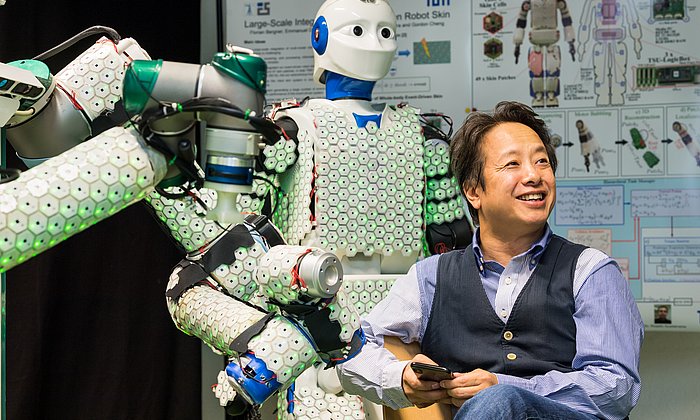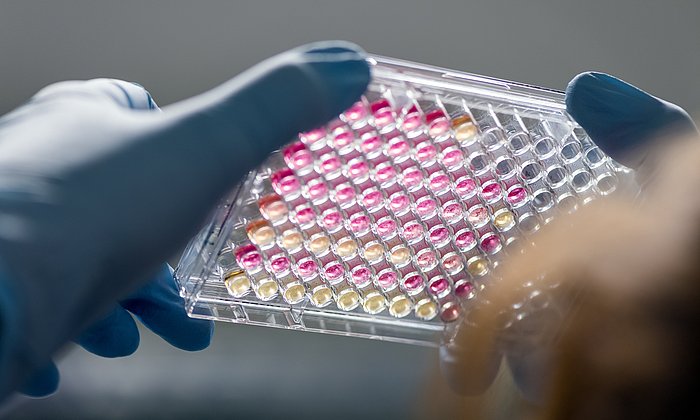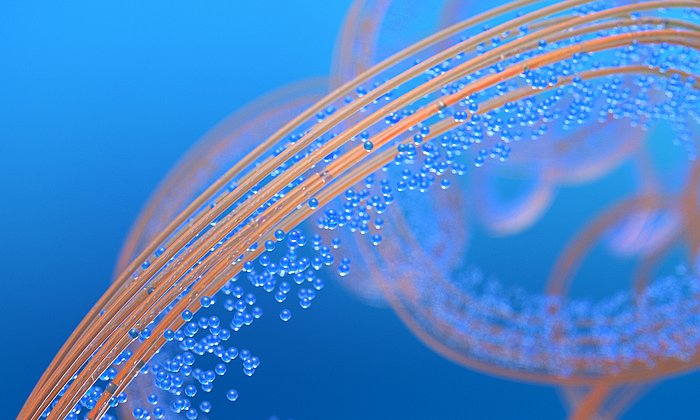Great success for promising researchers
Nine ERC Starting Grants for TUM in 2023

TUM President Prof. Thomas F. Hofmann congratulated the winners: "The ERC Starting Grants are a highly renowned, international confirmation of the scientific quality achieved by these researchers. TUM is thrilled to have these especially promising and talented individuals in its ranks. And I am very much looking forward to seeing the results of their exciting and leading-edge research projects."
To date TUM researchers have succeeded in winning a total of 198 of the prestigious ERC Grants, which are awarded each year in various categories. Starting Grants are intended for scientists who are still in the early phases of their careers. The Grants are endowed with as much as 1.5 million euros. In addition to the ERC Starting Grants, another TUM project has been singled out for a Proof-of-Concept Grant. This form of funding is awarded to scientists who want to see if their ERC research projects can be turned into marketable innovations.
Prof. Dr. Carina Baer de Oliveira Mann
Cyclic nucleotides are of essential importance to the cell as secondary neurotransmitters. They amplify signals within the cell and route the signals to the right destinations in order for example to trigger immune responses or regulated processes such as cell-fate decisions. Cyclic GMP-AMP (cGAMP) is the only cyclic dinucleotide known to exist in humans up to now. It is considered to be a highly promising candidate for the development of medications, for example in the fight against cancer or as a supporting substances in vaccines. In their project "NTase Products and Cyclic Nucleotide Signaling" Prof. Carina Baer de Oliveira Mann and her team are searching for further cyclic nucleotides. To do so they are developing and testing methods which activate certain enzymes in the family of the nucleotidyltransferases (NTases), which can among other things produce cyclic dinucleotides. As soon as they are activated, in the next step the researchers can analyze their products and thus identify new cyclic nucleotides and their signal paths.
Carina Baer de Oliveira Mann is Professor for Biomolecular Cryo Electron Microscopy at the TUM School of Natural Sciences .
Prof. Dr. Laura Classen
Similar to water, electrons in quantum materials can take on different states. However, the exact emergence and properties of these unusual material states are not yet completely understood. Thus in many quantum materials there is a complex mutual interaction between unusual magnetic, metallic and superconducting phases which cannot be explained using conventional many-body theory. In their project "Emergence in quantum materials: from relativistic quantum criticality to non-Fermi liquids and superconductivity", or QuantEmerge, Prof. Laura Classen and her team are investigating these phases with a new approach based on the step-by-step expansion of minimal models. It will not be possible to utilize the fundamental properties of quantum materials in applications such as the quantum computer until these properties can be understood and controlled.
Laura Classen is Professor of the Theory of Correlated Quantum Materials at TUM and heads the "Correlated Phases of Quantum Materials" research group at the Max-Planck-Institute for Solid State Research .
Dr. Daniel Keefer
Photochemistry is concerned with reactions which are made possible or influenced by the effects of light: One familiar example of this kind of reaction is photosynthesis. These reactions also play an important role in chemical catalysis and functional material in photovoltaics. The decisive processes in these reactions take place in ultra-short periods of time and have as yet not been explained in detail. Daniel Keefer and his team are simulating methods to make it possible to record videos of individual molecular movements in their project "Quantum Controlled X-ray Spectroscopy of Elementary Molecular Dynamics", or QuantXS. Here the decisive factor is a new approach based on coherent quantum control which allows an unprecedented degree of precision in measuring spectroscopic signals that are otherwise hard to resolve. The objective is to better understand the elementary steps of photochemical reaction and thus to generate new design principles for molecular applications in photovoltaics, photocatalysis and other technologies.
Daniel Keefer applied for the ERC Grant with TUM as the host institution. He is a group leader at the Max-Planck-Institute for Polymer Research .
Prof. Dr. Mrinalini Kochupillai
Until recently, European law severely restricted the use of agricultural biodiversity in agriculture. In recent years, however, the importance of using native seeds has been rediscovered. Because native seeds are adapted to regional conditions, they are naturally more robust and resistant to pests, diseases, and the effects of climate change. Since 2018, the European Union has allowed the use of native seeds in organic agriculture. Decades of banishment of regional seeds in agriculture led to the loss of important know-how needed to grow native seeds. In some countries, such as India, regional knowledge on the use of indigenous seeds remained. With the ERC start-up grant, Prof. Mrinalini Kochupillai and her team are developing a novel system in the ReSeed project that creates a transparent, decentralized and digital marketplace. On this platform, smallholder farmers can share their seeds and valuable know-how with other farmers and researchers around the world. ReSeed promotes incentives for the revival of the marketing of indigenous seeds by smallholders. Further, ReSeed will automate benefit-sharing with farmers, bringing both environmental and economic benefits to small farmers.
Mrinalini is currently a visiting professor at the TUM chair of Data Science in Earth Observation.
Prof. Dr. Kristen Kozielski
They are tiny and can stimulate our nerve cells with electrical impulses. Prof. Kristen Kozielski researches how neuroelectrodes can be utilized in the treatment of illnesses such as Parkinson's disease and spinal cord injuries. Nanoelectrodes intervene in the nervous system and can thus control muscle movements or ease pain. Until now nerve stimulation has only been considered as a therapy in isolated cases since the implants are very large and complex and require highly complicated surgical procedures. Because of their smaller size, the implants developed by Prof. Kozielski could be easier to transplant, minimizing the risk to the patient. Here the nanoelectrodes do not require any batteries, but rather are provided with electricity by the surrounding tissue. In the future this technology could be used to help more patients with disabilities in the brain or spinal cord.
Kristen Kozielski is Professor of Neuroengineering-Materials and Program Director of the Elite Master's Program for Neuroengineering.
Dr.-Ing. Christoph Meier
Laser Powder Bed Fusion (LPBF) is one of the most highly promising additive manufacturing techniques for metals. In the LPBF process material powder is spread evenly in thin (10-200µm) layers on a substrate plate and selectively melted using a targeted laser beam. This makes it possible to fabricate highly complex geometries which would be impossible to make using conventional manufacturing methods. However, this relatively young method has as yet only been able to reach very low manufacturing rates. As a result, LPBF has until now only been suitable for individualized products and small batches, e.g. patient-specific implants in medical technology or complex multifunction components in aerospace and aviation, but not for mass production. In the project ExcelAM Christoph Meier is working on innovative computer-based simulation models that are to make it possible to raise LPBF manufacturing rates by at least an order of magnitude. This is intended to facilitate the future application of LPBF in mass production, e.g. in the implementation of innovative, environmentally friendly drive technologies for the automotive industry.
Christoph Meier is a researcher at Prof. Wolfgang A. Wall’s chair of Computational Mechanics.
Dr. Michael Ratz
In the SpaRC project, Dr. Michael Ratz will investigate the influence genomic information on the connectome, i.e. the totality of the connections between the neurons of a brain. While these connections are usually studied using electron microscopy, Michael Ratz is taking a different approach: by genetically modifying viruses, he can provide each neuron in the brain of a mouse with a genetic barcode, so to speak. This makes it possible to track with whom the neuron communicates. To find out which genes are active in the connected neurons, Ratz wants to combine the method with spatially resolved RNA-sequencing. With this new tool for neurological research, Ratz wants to find out more about the effects of certain genetic variations. He is particularly interested in the basis of autism spectrum disorders.
Dr. Michael Ratz most recently conducted research at Sweden's Karolinska Insitutet. At TUM, his research group will be based at the Institute for Cell Biology of the Nervous System.
Dr. Michael Ratz currently is a researcher at Karolinska Insitutet in Sweden. At TUM, his research group is to be based at the Institute for Cell Biology of the Nervous System.
Prof. Dr. Janina Steinert
Physical and sexual violence against women by a partner has been the subject of many studies. However, an important dimension of intimate partner violence has been neglected: economic abuse. This includes denying women the right to participate in financial decisions, confiscating their income or preventing them from seeking employment. In the project Disentangling and Preventing Economic Violence against Women (ECOVI), Prof. Janina Steinert aims to determine the extent of economic abuse of women. She will investigate the causes of this phenomenon and how it relates to other types of intimate partner violence. In addition, she aims to develop and test preventive measures. The project will focus on the situation in India as an example.
Janina Steinert is Professor of Global Health at the Munich School of Politics and Public Policy at TUM (HfP).
Dr. Golo Storch
Reduction reactions play a major role in many processes in the chemical industry. Here the transfer of electrons results in the transformation of a raw material into the desired product. In organic chemistry the high reduction potential necessary for this process is usually taken from metals such as sodium, potassium or lithium, which are difficult to produce. In the ERC project "Artificial Catalysts for Endergonic Reduction by Electron Bifurcation", BifurCAT, Dr. Golo Storch and his team are applying a trick found in nature to make this kind of reaction possible with less effort. They are following the example of enzymes where what is called electron bifurcation takes place. At a reaction center of the enzyme two electrons from a molecule are transferred to the catalyst. Then the central step takes place: The two electrons are spatially separated in the catalyst. Here some of the energy of one of the electrons is transferred to the other, so that instead of two electrons with the same energy level, one electron with a higher reduction potential and one with a lower reduction potential result. This higher reduction potential can then be used for the desired reduction. Should the team succeed in realizing this process in the laboratory for the first time, it would be possible to utilize substances such as ascorbic acid or formic acid, which exist in large quantities, as energy sources for demanding reduction reactions.
Golo Storch is a group leader at the Chair of Organic Chemistry I .
Proof of Concept Grant: Prof. Dr. Gil Gregor Westmeyer
To develop new diagnostics and therapeutics, researchers are increasingly harnessing gene delivery techniques to genetically modify cells. However, efficient and safe delivery of genetic information to specific target cells remains a substantial obstacle. To address this challenge, the inteRNAlizer project, spearheaded by Gil Gregor Westmeyer, is developing a new, efficient system to deliver RNA to target cells without the use of viruses, which are often associated with biosafety risks. The modular system enables the selective and transient expression of genes in target cells and will thus foster biomedical research, particularly on challenging cell types, including those with therapeutic potential.
Gil Gregor Westmeyer is Professor of Neurobiological Engineering and a Principal Investigator at the Munich Institute of Biomedical Engineering (MIBE) .


